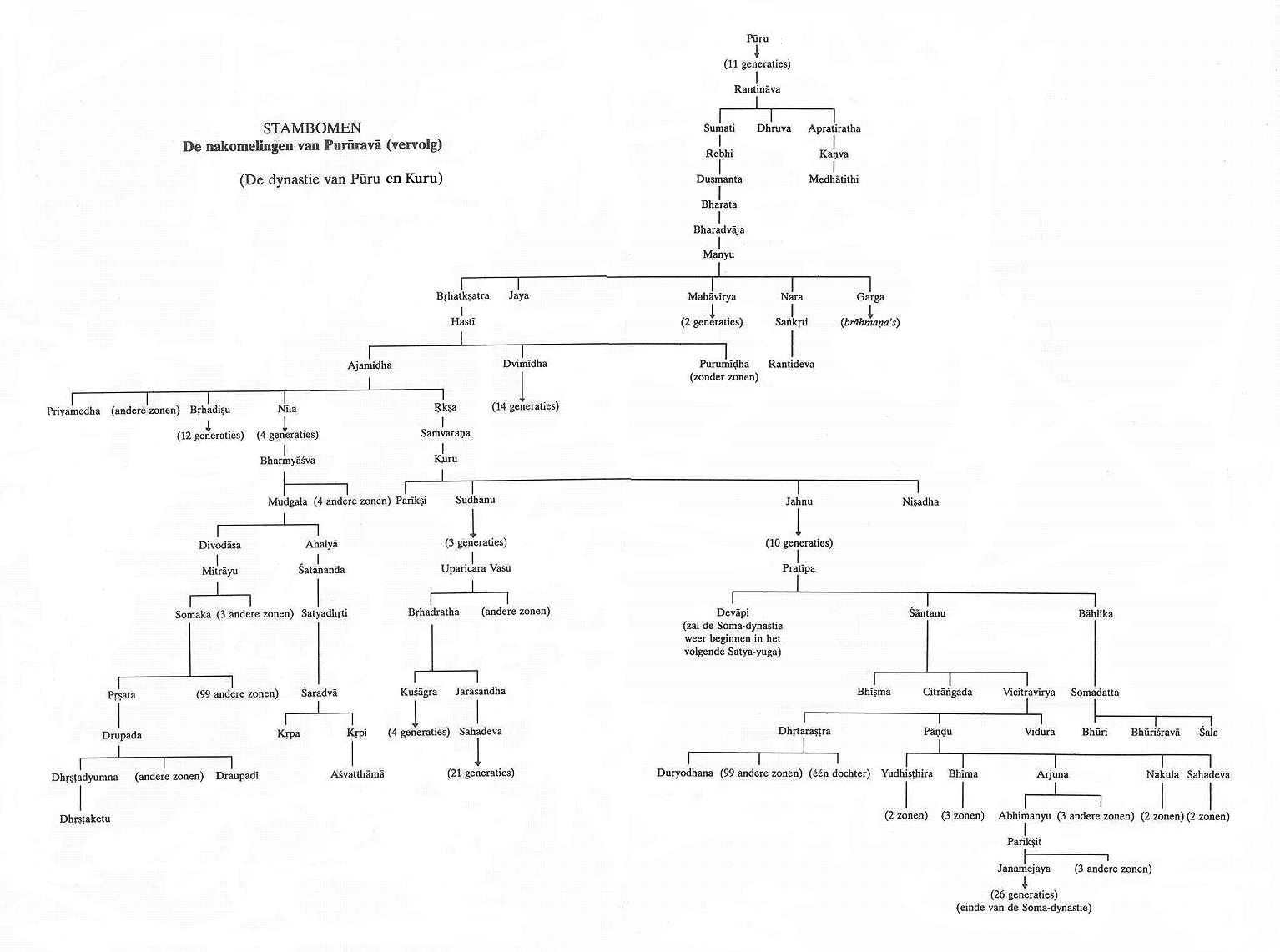From the Ninth Canto, Twenty-third Chapter, of the Śrīmad-Bhāgavatam,
entitled “The Dynasties of the Sons of Yayāti.”
Of the four sons of Yadu, Sahasrajit was the eldest. The son of Sahasrajit was named Śatajit. He had three sons, of whom one was Haihaya. The sons and grandsons in the dynasty of Haihaya were Dharma, Netra, Kunti, Sohañji, Mahiṣmān, Bhadrasenaka, Dhanaka, Kṛtavīrya, Arjuna, Jayadhvaja, Tālajaṅgha and Vītihotra.
The son of Vītihotra was Madhu, whose eldest son was Vṛṣṇi. Because of Yadu, Madhu and Vṛṣṇi, their dynasties are known as Yādava, Mādhava and Vṛṣṇi. Another son of Yadu was Kroṣṭā, and from him came Vṛjinavān, Svāhita, Viṣadgu, Citraratha, Śaśabindu, Pṛthuśravā, Dharma, Uśanā and Rucaka. Rucaka had five sons, one of whom was known as Jyāmagha. Jyāmagha was sonless, but by the mercy of the demigods his childless wife gave birth to a son named Vidarbha.
*
Text 30-31
O Mahārāja Parīkṣit, because Yadu, Madhu and Vṛṣṇi each inaugurated a dynasty, their dynasties are known as Yādava, Mādhava and Vṛṣṇi. The son of Yadu named Kroṣṭā had a son named Vṛjinavān. The son of Vṛjinavān was Svāhita; the son of Svāhita, Viṣadgu; the son of Viṣadgu, Citraratha; and the son of Citraratha, Śaśabindu. The greatly fortunate Śaśabindu, who was a great mystic, possessed fourteen opulences and was the owner of fourteen great jewels. Thus he became the emperor of the world.
PURPORT
In the Mārkaṇḍeya Purāṇa the fourteen kinds of great jewels are described as follows: (1) an elephant, (2) a horse, (3) a chariot, (4) a wife, (5) arrows, (6) a reservoir of wealth, (7) a garland, (8) valuable costumes, (9) trees, (10) a spear, (11) a noose, (12) jewels, (13) an umbrella, and (14) regulative principles. To be the emperor, one must possess all fourteen of these opulences. Śaśabindu possessed them all.
*
Text 32
The famous Śaśabindu had ten thousand wives, and by each he begot a lakh of sons. Therefore the number of his sons was ten thousand lakhs.
*
https://prabhupadabooks.com/sb/9/23
*
Note:
One Lakh is a unit in the Indian numbering system equal to one hundred thousand (100,000).
10,000 Lakh means 10,000 x 100,000 =…..I give up…
If one starts counting the descendants (sons, grandsons etc) of Yadu, Madhu and Vṛṣṇi one comes to approximately 20 generations of descendants until ca. 5000 years ago. Before this Kaliyuga there was Dvāparayuga where the lifespan was 1000 years. In addition one can see in Text 32 what kind of virility that man had:
“The famous Śaśabindu had ten thousand wives, and by each he begot a lakh of sons. Therefore the number of his sons was ten thousand lakhs.”
Dvāparayuga lasts for 864,000 years, the lifespan for humans is 1000 years and this guy Śaśabindu had millions of sons and he was able to maintain his huge “family” opulently, house them, feed them, clothe them. What? Most people today have a hard time just to get by.
To what a sorry state is earth and everything in and on it reduced these days. On top of it: considering the timeline of the universe, the battle of Kurukṣetra was just yesterday. Unbelievable. No wonder they put a big wall around us, locked us up and threw away the keys…








In the Mārkaṇḍeya Purāṇa the fourteen kinds of great jewels are described as follows: (1) an elephant, (2) a horse, (3) a chariot, (4) a wife, (5) arrows, (6) a reservoir of wealth, (7) a garland, (8) valuable costumes, (9) trees, (10) a spear, (11) a noose, (12) jewels, (13) an umbrella, and (14) regulative principles.
14 great Jewels….and by the Mercy of Śrīla Prabhupāda we are gifted with Nr. 14….who cares about the other 13….broken Pieces of Glass.
Only the 14th Jewel gives the final Upgrade to the one and only transcendental, truly royal Cruise Liner. The 14th Jewel will prepare for Purity of Speech, of the Mind, of the Senses, plus a compassionate Heart paired with heaps of transcendental good Luck, required by one who seeks to board the divine Vessel.
The other 13 Treasures are for economy class Costa Rides.